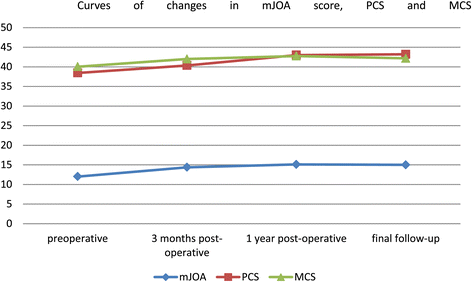Assessment of health-related quality of life using the SF-36 in Chinese cervical spondylotic myelopathy patients after surgery and its consistency with neurological function assessment: a cohort study
- PMID: 25889912
- PMCID: PMC4380110
- DOI: 10.1186/s12955-015-0237-1
Assessment of health-related quality of life using the SF-36 in Chinese cervical spondylotic myelopathy patients after surgery and its consistency with neurological function assessment: a cohort study
Abstract
Background: We aimed to calculate the responsiveness and statistically prove the reliability of the Medical Outcomes Study Short Form Health Survey (SF-36) in a prospective cohort study. We investigated the profile of mid-term health-related quality of life (QOL) outcome assessments after surgery for cervical spondylotic myelopathy (CSM) and determined the consistency of the SF-36 assessments of neurological function.
Methods: A total of 142 consecutive patients with CSM who underwent surgery were enrolled in the study. QOL and neurological assessments were evaluated before and at 3 months, 1 year, and more than 2 years postoperatively. We subsequently analyzed the reliability and responsiveness of the SF-36 and the QOL profile for its consistency regarding the neurological function assessment.
Results: (1) Cronbach's α ranged from 0.73 (for role-emotional) to 0.85 (for physical function). The effect size ranged from 0.57 to 0.93 for SF-36's eight scales. Minimum clinically important differences (MCIDs) in the physical scores (PCS) and mental scores (MCS) were 5.52 and 3.43, respectively. (2) The scores for all SF-36 scale sections indicated that patients with CSM were significantly impaired compared with healthy adults. SF-36 PCS and MCS peaked at 17.7 and 18.9 months after surgery, respectively. (3) At 3 months after surgery, improvements in the modified Japanese Orthopaedic Association (mJOA) scores significantly correlated only with patients' physical function and bodily pain scores. At 1 year after surgery, improvements in the mJOA scores significantly correlated with physical function, general health, social function, and role-emotional. At the final follow-up, improvements in the mJOA scores significantly correlated with physical function, vitality, and role-emotional.
Conclusions: SF-36 is reliable and has moderate responsiveness for evaluating patients with CSM, with MCID at 5.52 for the PCS and at 3.43 for the MCS. The preoperative QOL of the CSM patients was severely impaired compared with that of the normal population. Postoperatively, each SF-36 domain improved to a variable degree. During the early stage of recovery the mJOA score improvements correlated with SF-36's physical component domains, whereas during the later stages the improvements were associated with the mental component domains.
Figures
References
Publication types
MeSH terms
LinkOut - more resources
Full Text Sources
Other Literature Sources
Medical


